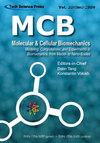Approach to the Flow Rate Distribution of Coronary Branches in the Calculation of Fractional Flow Reserve
Q4 Biochemistry, Genetics and Molecular Biology
引用次数: 2
Abstract
In order to improve the calculation accuracy of computed tomography angiography-derived fractional flow reserve (FFRCT), a mathematical model for setting the patient-specific flow boundary condition was proposed, in which some independent physiological parameters, such as myocardial mass, diastolic blood pressure, heart rate and vessel volume were considered. This model was employed to simulate hemodynamics in sixteen patients with coronary stenosis. The results of FFRCT demonstrated good consistency with invasively measured FFR. The diagnostic accuracy of FFRCT was 85%. The proposed model offers a new approach to improve the accuracy of FFRCT, as well as promotes the clinical application of FFRCT.分流储备计算中冠状动脉分支流速分布的探讨
为了提高ct血管造影衍生分数血流储备(FFRCT)的计算精度,提出了一种考虑心肌质量、舒张压、心率、血管容积等独立生理参数的患者特异性血流边界条件设置数学模型。应用该模型模拟16例冠状动脉狭窄患者的血流动力学。FFRCT的结果与有创测量的FFR具有良好的一致性。FFRCT的诊断准确率为85%。该模型为提高FFRCT的准确率,促进FFRCT的临床应用提供了新的途径。
本文章由计算机程序翻译,如有差异,请以英文原文为准。
求助全文
约1分钟内获得全文
求助全文
来源期刊

Molecular & Cellular Biomechanics
CELL BIOLOGYENGINEERING, BIOMEDICAL&-ENGINEERING, BIOMEDICAL
CiteScore
1.70
自引率
0.00%
发文量
21
期刊介绍:
The field of biomechanics concerns with motion, deformation, and forces in biological systems. With the explosive progress in molecular biology, genomic engineering, bioimaging, and nanotechnology, there will be an ever-increasing generation of knowledge and information concerning the mechanobiology of genes, proteins, cells, tissues, and organs. Such information will bring new diagnostic tools, new therapeutic approaches, and new knowledge on ourselves and our interactions with our environment. It becomes apparent that biomechanics focusing on molecules, cells as well as tissues and organs is an important aspect of modern biomedical sciences. The aims of this journal are to facilitate the studies of the mechanics of biomolecules (including proteins, genes, cytoskeletons, etc.), cells (and their interactions with extracellular matrix), tissues and organs, the development of relevant advanced mathematical methods, and the discovery of biological secrets. As science concerns only with relative truth, we seek ideas that are state-of-the-art, which may be controversial, but stimulate and promote new ideas, new techniques, and new applications.
 求助内容:
求助内容: 应助结果提醒方式:
应助结果提醒方式:


